Discovery livesby Jason Callahan
|
| Discovery is a fierce competition. In this latest round NASA received 28 proposals, which is the same number the agency received in 2010. |
NASA’s planetary science missions are broken into three classes. The Discovery program represents the small mission class. The New Frontiers program, consisting of competitively selected missions capped at roughly $1 billion (including launch vehicle), are medium-class missions (see “New life for New Frontiers”, The Space Review, February 23, 2015). Large planetary missions at NASA, also called flagships, are selected strategically and cost over $1 billion.
Each mission class offers different benefits, and the strength of Discovery missions lies in their frequency. By flying more frequently than the larger missions, Discovery projects allow scientists greater opportunities and shorter waiting periods to fly their instruments, a particularly important proposition for early-career scientists. And since Discovery missions are competitively selected, they provide increased opportunities for scientists outside of NASA centers to design missions.
And Discovery is a fierce competition. In this latest round NASA received 28 proposals, which is the same number the agency received in 2010 during the twelfth Discovery mission competition. This round includes a number of new competitors, while some from the last round are not competing this time. The competition is particularly strong this round in part because of the long wait for NASA’s solicitation for proposals. Discovery competitions are supposed to occur every two to three years.
NASA will now conduct reviews of all 28 proposals, evaluating them in terms of science quality, technical maturity, and cost. Each of these factors is important. The proposed mission must answer scientific questions that the planetary science community is interested in, the spacecraft must not rely on technology that is insufficiently mature, and the mission must have a good chance of staying within the cost cap, as determined by an independent group hired by NASA to perform an evaluation.
NASA’s track record on staying below fixed cost caps for planetary missions has been good over the last decade. The last Discovery mission, GRAIL, came in slightly under budget, as did the analogous Mars Scout mission MAVEN. The OSIRIS-REx New Frontiers mission is also currently staying within budget. The one major exception in the last ten years was the Mars Science Laboratory, a flagship mission that included the rover Curiosity, which significantly overran its initial cost and schedule estimates.
NASA released the twelfth Discovery announcement of opportunity (a solicitation for project proposals) in 2010, and in May 2011 NASA selected three mission proposals for further study and three projects for additional technology development. The three mission proposals were Titan Mare Explorer (TiME), a boat that would land on one of Titan’s lakes, Comet Hopper (CHopper), a spacecraft that would hop around to several locations on the surface of a comet, and InSight, a Mars lander that would deploy a seismometer and other instruments on the Martian surface to determine if Mars is still geologically active. The three technology development projects were Primitive Material Explorer (PriME), a mass spectrometer that could be used on multiple spacecraft, the detector for the NEOCam asteroid survey spacecraft, and Whipple, a telescope using a new technique for detecting objects in the outer solar system. In August 2012 NASA announced that it would select InSight, which is based on the Phoenix lander and is scheduled for a 2016 launch.
Both TiME and CHopper would have used plutonium-powered Advanced Stirling Radioisotope Generators (ASRGs) for power, but tight budgets forced NASA to halt development on the ASRG, so no such power sources are available for this round. And unfortunately, a shift in orbital geometry means that the TiME mission is no longer possible. Thus, some Discovery proposals get only one shot before circumstances turn against them. Often proposals that have come very close to selection do not get resubmitted by scientists who move on to other projects.
| NASA’s track record on staying below fixed cost caps for planetary missions has been good over the last decade. The last Discovery mission, GRAIL, came in slightly under budget. |
NASA does not disclose which proposals it receives for Discovery competitions and mission proposers do not have to make any aspect of their participation public. Some principal investigators choose to keep their proposals secret so as not to tip off their competitors. Considering that it is common for teams to lose one or more times before they are eventually selected, there is logic to this secrecy. Unusually (and somewhat surprisingly), two thirds of the proposing teams during this thirteenth round have publicly revealed basic information about their proposals.
Because the principal investigators for so many of these missions have gone public, it is possible to discuss them, although generally not in much detail. There is considerable information available for some of them, such as IVO, but little more than a discussion of science goals for others. The missions listed below are categorized by target or mission type.
Moon mission proposals
Following the Apollo program, two decades passed before the United States returned a spacecraft to the Moon. The Department of Defense’s Clementine spacecraft orbited in the early 1990s, later followed by the third Discovery mission, Lunar Prospector, and the eleventh Discovery mission, GRAIL. NASA has also launched LADEE, LCROSS, and the Lunar Reconnaissance Orbiter (LRO) as part of other programs. LRO still operates around the Moon, although the President’s most recent budget proposes shutting it down and ending American presence at the Moon. The Moon still poses many scientific questions, but because we have already studied it in detail many of those questions are more complicated and require more complex spacecraft to answer, and some of those spacecraft are too expensive to fit in the Discovery program. Nevertheless, some scientists continue to propose Discovery lunar missions. Two of them are publicly known for this Discovery round.
NanoSWARM is a CubeSat Discovery mission to study space weathering, lunar magnetism, lunar water, and small-scale magnetospheres. It would consist of several CubeSats in lunar orbit. NASA is currently undertaking a small CubeSat mission known as Lunar Flashlight, but so far no CubeSats have ventured beyond low Earth orbit, so this would be a novel mission.
MARE (Moon Age and Regolith Explorer) is a proposed lunar lander mission that would provide more accurate dating of the lunar surface than can be achieved without bringing samples all the way back to Earth.
Phobos/Deimos mission proposals
The Martian moons Phobos and Deimos have always been bridesmaids and never brides when it comes to Discovery mission proposals. Scientists have proposed Phobos-Deimos missions at least a handful of times before, such as the Aladdin mission proposal that came very close to selection in 1999. Russia launched the Phobos-Grunt mission in 2011 to bring a sample of Phobos back to Earth only to have the spacecraft fail as soon as it reached Earth orbit. Future Russian Phobos plans appear to be on hold due to the country’s financial situation. The moons pose a number of scientific questions, such as their origin—are they captured asteroids or parts of Mars itself?—and the nature of unusual features on Phobos’ surface. One question of possible interest to future human missions to Mars is whether the moons contain any volatiles. There are three proposals for missions to these moons during this Discovery round, two orbiters and a lander.
PANDORA (Phobos ANd Deimos ORigin Assessment) is a JPL Phobos/Deimos mission that would use a Boeing spacecraft equipped with solar-electric propulsion.
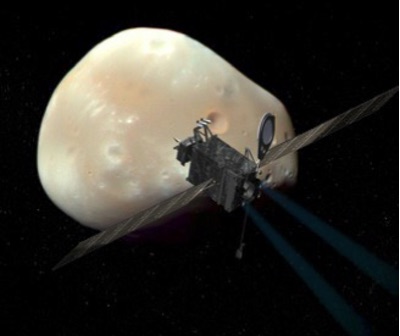 Artist’s concept of the PANDORA spacecraft in front of Deimos. (credit: JPL) |
PADME (Phobos And Deimos & Mars Environment) is an Ames Research Center Phobos/Deimos mission that would use a spacecraft similar to the LADEE lunar orbiter launched in late 2013. Compared to PANDORA, PADME would carry fewer instruments but would be cheaper.
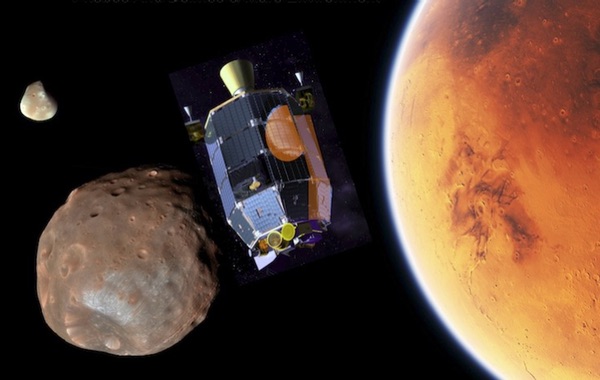 Artist’s concept of the PADME spacecraft at Mars. (credit: NASA) |
MERLIN (Mars-Moons Exploration, Reconnaissance and Landed Investigation) is a Johns Hopkins Applied Physics Laboratory-led proposal for a Phobos lander. It would conduct in situ measurements of Phobos.
Venus mission proposals
The last NASA mission to Venus, Magellan, launched in 1989, so one could argue that it is past time that NASA returned to Earth’s hellish twin. During the last Discovery competition NASA received seven Venus mission proposals, including four radar missions. This time there are apparently four Venus missions, although only three of them have been publicly announced.
VASE (Venus Atmosphere and Surface Explorer) is a Venus atmospheric mission that would deploy balloons to Venus and drop an impactor to the surface that would take close up images of the surface during its descent.
RAVEN (Radar At VENus) is a Venus radar mission that would map the surface at higher resolution than Magellan did before finally ending its mission in 1992. It is led by researchers from the University of Alaska with Boeing participation.
VERITAS (Venus Emissivity, Radio Science, InSAR Topography and Spectroscopy) is another radar mission led by JPL.
Outer planets mission proposals
It can take five years or more for a spacecraft to reach Jupiter, and even longer to reach Saturn, and because of their distance from the Sun the outer planets pose challenging power requirements. Only a few years ago it was inconceivable to use solar power at Jupiter’s distance from the Sun, but NASA’s Juno mission is currently heading to Jupiter and will use large solar panels, and the Europa Clipper mission will also use solar power. Suddenly solar is viable for some outer planets missions, at least at the distance of Jupiter.
IVO, the Io Volcano Observer, is a mission to study the volcanic, ever-changing Jovian moon Io. During the last Discovery round IVO was a spacecraft proposal that would have used a plutonium-powered ASRG, but this time it will operate using what the scientists dub “remote fusion power,” otherwise known as the Sun. IVO’s principal investigator, Alfred McEwen, of Arizona State, has spoken in detail about this mission and provided extensive summaries of the mission design and instrumentation, in addition to the science.
Enceladus Life Finder is a mission that would send a solar-powered spacecraft to Enceladus, the Saturnian moon known to have geysers. ELF’s solar panels are over 43 meters from end to end, and the spacecraft would use various instruments to try to detect life at the tiny, but thermally active moon.
Planetary telescope proposals
Before the space age the only way to study the planets was to use telescopes. Today telescopes are still important for many planetary observations, particularly of more distant objects such as the ice giants Uranus and Neptune, and Kuiper Belt Objects beyond Pluto. Kepler was a Discovery mission that later got taken over by NASA’s astrophysics division and has gone on to fame and glory detecting planets around other stars, but planetary scientists have been talking about space-based telescopes for looking within our solar system.
Whipple was a telescope proposal that was selected for technology development funding in the last Discovery round in 2011. It would use a new technique called “blind occultation” to find objects in the outer solar system and determine the structure of our solar system beyond Pluto. Relatively little information is available about this mission.
NEOCam is a JPL mission that was also selected for technology funding in the last Discovery round and is presumably competing again. The tech funding went to support the development of the telescope sensor, which presumably would be integrated into any new spacecraft if NASA chooses to build it. NEOCam is a survey mission that would detect a large number of near Earth objects that are too small or faint to be spotted with ground-based telescopes.
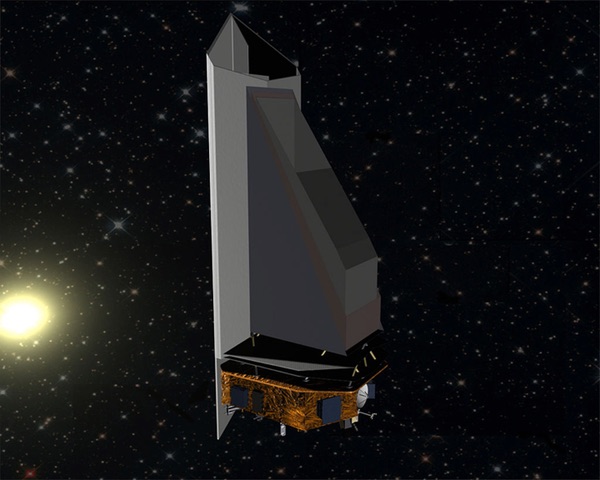 Artist’s concept of NEOCam. (credit: JPL) |
Kuiper is a planetary telescope proposal for looking at a number of different objects and phenomena in the solar system. Because it is expensive and time consuming to send missions to the outer planets and to observe their atmospheres, magnetospheres, and moons, Kuiper would view them remotely. It would be able to monitor the complex weather on Jupiter, Saturn, and the ice giants, and could also view their aurorae. And it would provide a powerful tool for finding and characterizing the mysterious objects in the Kuiper Belt, possibly finding other bodies larger than Pluto.
Asteroid mission proposals
Psyche is a mission to a metal-rich asteroid. Observations indicate that the asteroid Psyche has a surface that is 90% metallic. The spacecraft would orbit Psyche and take measurements.
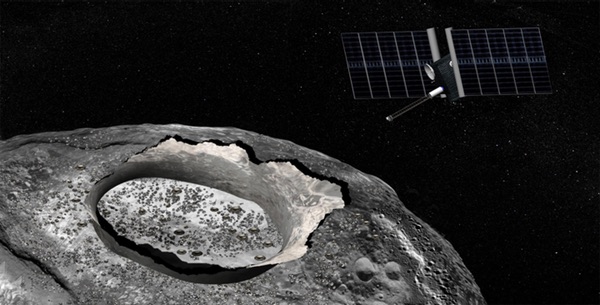 Artist’s concept of asteroid Psyche and spacecraft. (credit: JPL/Corby Waste) |
Lucy is a mission that would journey to the Trojan asteroids. This class of asteroid occupies locations leading and trailing Jupiter’s orbit. They are essentially captured there by gravity and as a result could be left over from the early period of solar system formation. There is relatively little public information available about Lucy.
DARe (Dark Asteroid Rendezvous) is apparently a mission to visit up to nine asteroids using what the proposers refer to as a “high heritage” spacecraft equipped with ion propulsion—essentially a spacecraft similar to Dawn which is currently orbiting Ceres. Based upon the limited data available it is unclear if the targets are near Earth asteroids or those farther out.
BASiX (Binary Asteroid in-situ Explorer) is a mission to visit an asteroid with a satellite of its own, something that is surprisingly common among asteroids. The goal would be to set off small explosions to see how that affects the movement of both objects.
Comet mission proposal
The European Space Agency’s Rosetta mission and the exploits of its wobbly lander Philae demonstrate that comets can fascinate the public and hold many scientific secrets. What particularly interests scientists is the possible presence of organic materials on comets. Although there are probably at least a couple of comet mission proposals this Discovery round, only one is publicly known.
CORE (COmet Radar Explorer) is a mission to put a spacecraft close enough to a comet to map its interior using ground/ice penetrating radar, and also map its surface.
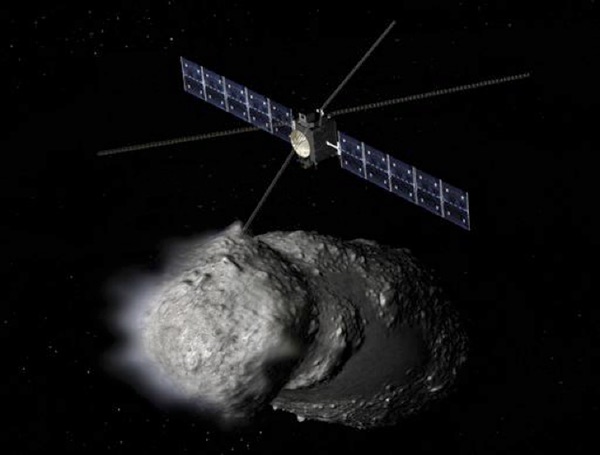 Artist’s concept of the CORE spacecraft. (credit: JPL(?)) |
Mars mission proposals
Up until 2010 NASA had a separate class of small mission proposals for Mars known as Mars Scout. Both the Phoenix lander and MAVEN were Mars Scout missions. But in 2010 Mars Scout was discontinued and Mars missions were then included in the Discovery program. The most recent Discovery mission selection, InSight, will head to Mars in March 2016.
Mars Icebreaker Life is an Ames Research Center mission based on the Phoenix lander. It would follow up on Phoenix’s discoveries, but also use different sampling devices and instruments to try to overcome some of the frustrating problems that Phoenix encountered. The goal is to determine whether the ice fields near Mars’ poles are habitable and might contain complex organic chemistry.
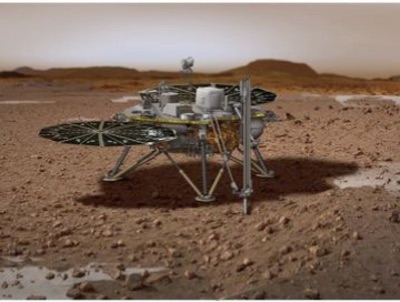 Artist’s concept of Mars Icebreaker Life spacecraft. (credit: NASA) |
A plethora of worlds to choose from
The above list includes 19 missions. In addition, the author is aware of another Venus mission and another comet mission, although their principal investigators have not publicly revealed them. Although the list is incomplete, it is still possible to draw a few conclusions about the Discovery program and the American planetary scientific community.
| Perhaps the most interesting development in the Discovery program is the emergence of solar-powered outer planets missions like the Enceladus Life Finder and the Io Volcano Observer. |
The first conclusion is that there is a lot of scientific interest in the Discovery program. Putting together a proposal requires people who are interested in doing the work, and institutions—NASA centers, universities, industry contractors—willing to spend the money on the proposals. According to insiders, these proposals can cost a quarter of a million dollars or more to assemble, so twenty-eight proposals, involving hundreds, if not thousands of participants represents a substantial expenditure. If we assume that only a quarter of these proposals are actually viable, that will still give NASA seven missions to choose from. Although it is likely the agency will only eventually select one, the number of proposals indicates that the field is healthy and there are a lot of people with ideas for space missions. NASA is not running out of proposals and the Discovery program is not about to whither due to lack of interest.
What that also highlights is that there are a lot more opportunities out there if NASA wants to take them. The last Discovery selection was nearly five years ago. The Planetary Science Decadal Survey recommended a higher cadence of Discovery missions, essentially one every two years. Certainly there are more possible missions than NASA is being given money to pursue.
Discovery has long been suited to asteroid, comet, and lunar missions. The publicly available proposals indicate that Venus remains a major interest among planetary scientists, perhaps a reflection of the long time since the last NASA mission there.
Also interesting is the fact that several planetary telescopes are in the mix. Telescopes offer the opportunity of doing science at targets too far to reach, like Kuiper Belt Objects, or multiple targets like the atmospheres of the outer planets.
But perhaps the most interesting development in the Discovery program is the emergence of solar-powered outer planets missions like the Enceladus Life Finder and the Io Volcano Observer. The Juno spacecraft has already proven that solar panels at Jupiter distance are viable, and should start providing hard data on their performance in 2016. Are they also a viable option for Saturn? And can an outer planets mission be built on a Discovery-class budget?
One lesson from past competitions is that winning proposals had usually lost in previous competitions. In fact, the most recent New Frontiers missions, OSIRIS-REx and Juno, had previously been proposed as Discovery missions. Losing proposal teams are briefed on weaknesses in their proposals and often come back stronger later.
Right now NASA’s plan is to select proposals for additional study by September. Although the last time NASA selected three proposals for further study and three technologies for further development there is no hard and fast rule for what it has to do this time. If more missions are considered viable NASA could select more for further study and technology development. But based upon current plans and funding profiles, NASA will probably select a single mission for full funding by fall of 2016, with a launch probably in 2020 or 2021: destination currently unknown, but somewhere out there in the dark.
